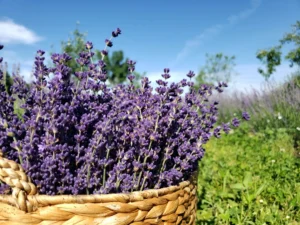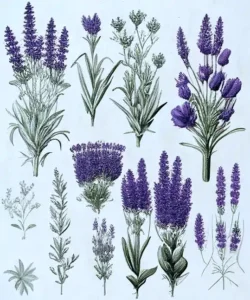Your cart is currently empty!

Lavender is a fragrant and versatile herb, beloved for its calming scent, stunning purple blooms, and adaptability in both culinary and medicinal applications. Whether you’re looking to grow lavender for its beauty, its essential oils, or simply for a low-maintenance, drought-tolerant plant, lavender can thrive in many different climates and settings – with the right care. In this guide, we’ll walk you through everything you need to know about growing lavender in your own garden.
1. Choosing the Right Variety

Before you start planting, it’s important to choose the right type of lavender. There are several varieties of lavender, and each has its own ideal growing conditions. The most common types of lavender are:
- English Lavender (Lavandula angustifolia): Known for its compact size and fragrant flowers, English lavender is one of the most popular varieties for gardeners. It’s ideal for colder climates and can survive winter temperatures down to -10°F (-23°C).
- French Lavender (Lavandula dentata): This variety features jagged-edged leaves and more aromatic blooms. It thrives in warmer climates and doesn’t tolerate frost well.
- Spanish Lavender (Lavandula stoechas): Recognizable by its unique, pineapple-shaped blooms with “rabbit ear” petals, Spanish lavender is best suited for regions with mild winters and hot summers.
- Lavandin (Lavandula x intermedia): A hybrid between English and French lavenders, lavandin grows tall with larger flowers and is often used for oil production.
You can learn more about different species and cultivars of lavender in this post.
2. Selecting the Ideal Location
Lavender loves sunlight and thrives in full sun, so choose a location in your garden that gets at least 6-8 hours of direct sunlight per day. Lavender also prefers well-drained soil that’s on the slightly alkaline side. Avoid areas where water tends to pool or where the soil remains damp for long periods of time, as lavender is prone to root rot.
If your soil is heavy or clay-like, consider planting lavender in raised beds or containers to ensure good drainage. You can amend your soil with sand or gravel to improve drainage if necessary.
3. Preparing the Soil
Lavender requires soil with a pH between 6.7 and 7.3. To achieve this, test your soil’s pH and amend it as needed. If your soil is too acidic (below 6.0), add lime to raise the pH. Lavender prefers slightly alkaline soil, which is similar to its native Mediterranean environment.
To improve drainage, mix in some organic matter like compost, but be careful not to overdo it. Lavender doesn’t need rich, fertile soil – it thrives in poorer soil conditions as long as the drainage is excellent.
4. Planting Lavender

You can start growing lavender from seeds, cuttings, or nursery plants. While starting from seed is an option, it’s often quicker and easier to buy a healthy young plant from a nursery, especially if you’re new to gardening.
Step-by-step Planting Instructions:
- Timing: The best time to plant lavender is in the spring after the danger of frost has passed, or in the fall in milder climates. Find the first frost date in your region and be sure to leave 6-8 weeks for the plant(s) to become established.
- Spacing: Spacing depends on the cultivar you are planting. Determine the spread of the variety and add a few inches to be on the safe side.
- Planting Depth: Dig a hole just deep enough to accommodate the root ball. The top of the root ball should be level with the surrounding soil. Be careful not to plant lavender too deep, as this can lead to crown rot.
- Watering: Water your lavender gently after planting, but avoid overwatering. Lavender is drought-tolerant once established, but it needs a good soak to settle the roots into the soil. In areas with average rainfall, you should provide some water, but not too much, for the first 2 – 3 week to make sure the plant has established itself. If you are in a more arid area, you might need to water more frequently.
5. Caring for Lavender
While lavender is a low-maintenance plant, it does require some basic care to thrive.
Don’t harvest any blooms in the first year to allow the plant’s energy to be directed to root development. Pinch off the buds as they appear.
Watering:
Lavender is highly drought-tolerant once established, but it does need regular watering during its first growing season to establish a deep root system. Water deeply but infrequently, allowing the soil to dry out between waterings. Overwatering is one of the most common causes of lavender death, so always check that the soil is dry before adding more water.
Pruning:
Pruning is essential for maintaining the shape and health of your lavender plant. To encourage new growth and prevent the plant from becoming too woody, trim back the plant by about one-third after the blooming period ends, usually in late summer or early fall. Be sure to remove any dead or damaged stems as well. Avoid cutting back into the woody base of the plant, as lavender does not regenerate well from old wood.
Fertilizing:
Lavender is not a heavy feeder. Too much fertilizer can lead to leggy growth and fewer flowers. If your soil is poor, you can feed lavender with a small amount of balanced fertilizer once in early spring. Organic compost can also be used sparingly.
Winter Care:
In colder climates, lavender may need some winter protection. After pruning, add a layer of well draining mulch around the base of the plant to help protect the roots from freezing temperatures. Don’t use mulch that holds water, such as wood chips. In extremely cold climates, consider covering your plants with burlap or creating a simple frame to protect them from harsh winds and frost.
6. Harvesting Lavender
Lavender can be harvested when the buds have formed but only 30-50% have fully opened. This will be dependent on the cultivar you are planting. To harvest, simply cut the flower stems just above the leaves with sharp garden shears or scissors. You can gather a few stems at a time or a whole bunch, depending on your needs.

Once harvested, you can hang lavender bundles upside down in a dry, cool, and dark place to allow them to air-dry. For a small amount, a closet might do. For larger amounts, you might need to black out the windows. This will preserve the fragrance and color of the flowers (be sure to keep the lavender bunches out of sunlight while drying, otherwise the color will fade). There also should be adequate airflow. We use fans to ensure there is enough air moving in the drying shed. After drying, you can strip and store the buds in airtight containers or use them to make sachets, essential oils, or dried flower arrangements.
7. Common Pests and Problems
Lavender is relatively pest-resistant, but there are a few common issues that you may encounter:
- Root Rot: As mentioned, lavender is susceptible to root rot if the soil doesn’t drain well. Make sure your soil is light and well-draining to prevent this problem.
- Lavender Sawfly: This pest can strip lavender leaves of their foliage. If you spot this, prune away affected areas and consider using natural insecticidal soap.
- Aphids: While lavender is generally resistant to aphids, they can occasionally target young plants. Regular inspection and the use of beneficial insects like ladybugs can help control aphid populations.
- Mildew: If your lavender is kept in a humid environment or overwatered, it may develop powdery mildew. Ensure good air circulation and avoid getting the leaves wet when watering.
8. Lavender Uses
Beyond its beauty, lavender is highly versatile. Some common uses include:
- Aromatherapy: Lavender essential oil is prized for its calming properties and is commonly used in diffusers, lotions, and even in baths.
- Cooking: The dried or fresh flowers or buds of lavender can be used in culinary dishes, particularly desserts like lavender shortbread or infused in syrups. Dried buds are more potent so be sure to reduce the amount used.
- Crafting: Dried lavender makes lovely additions to bouquets, sachets, wreaths, and other handmade crafts.
Conclusion
Lavender is a beautiful, fragrant herb that can thrive in many garden settings with minimal effort. By choosing the right variety, providing the ideal growing conditions, and offering some basic care, you can enjoy the lovely blooms and soothing scent of lavender for years to come. Whether you’re growing it for its visual appeal, fragrance, or uses in cooking and crafting, lavender is a rewarding and low-maintenance plant for any gardener.
Happy gardening!
